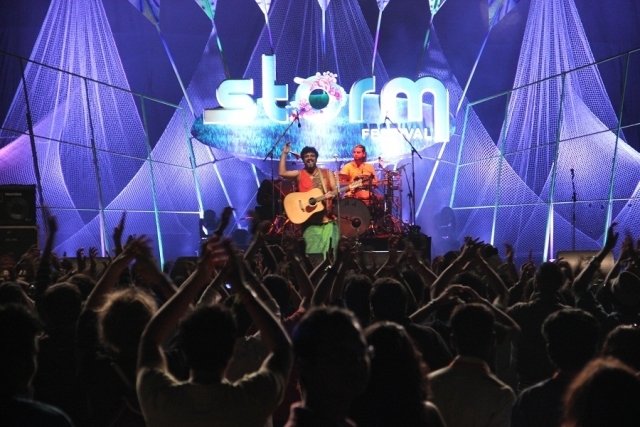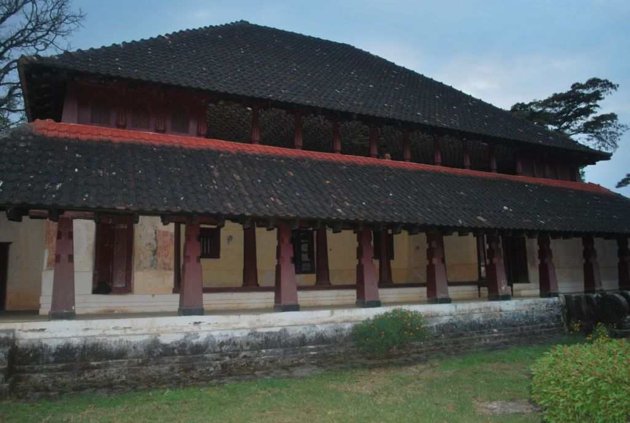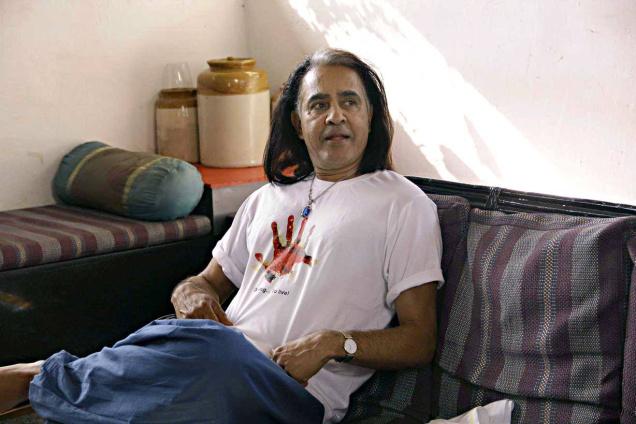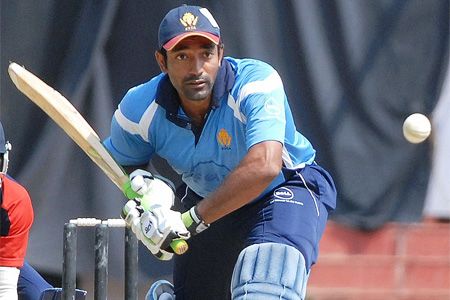Now in its second year, the camping festival still has to overcome many teething issues.

The Raghu Dixit Project. Photo: Imran Ahamed/ Storm Festival
February 1 and 2, Madikeri:
The first thing you should know about Storm Festival is that you don’t just wake up and attend the festival. It requires meticulous planning and packing. The eight hour journey from Bengaluru to Coorg was exhausting to say the least and there’s little one could have done to avoid squabbling with the security once we landed there.
We went through rigorous checking for this drug-free festival. Considering most festivalgoers were camping on site, they arrived with a bag of clothes, toiletries, a camera, but except for clothes, little else was allowed in. “Do they expect us to toss our cameras in the river?” ranted a festivalgoer, who was pulled up at the security. The scene repeated itself on multiple occasions during day one, with bags being ransacked, clothes tossed around, water bottles, perfumes and toothpastes confiscated and teabags taken out for further inspection. Instead of metal detectors, the second level of security meant an encounter with sniffer dogs before festivalgoers could step foot into Storm Fields, the camping site at the festival. Not the best start.
The venue for the festival, a sprawling tea estate, bore semblance to a theme park, almost like the fantasy world of Takeshi’s Castle with life-size installations including a mermaid in red bikini. Maybe a case of misplaced geography… Hills missing the beach? With the sun at its harshest, the concert space lay in comatose, while Stormers were seen paintballing, rock climbing, riding bronco bulls and ATVs, sliding on ziplines and leaving no time to wrestle one another in chicken-like outfits.
A visit to the camping site, with oven hot tents, ensured we got to the performance area as quickly as possible. The stages were named Paddy [acoustic sets], Spice [EDM], Coffee [folk] and Honey [midnight jam space], with the EDM and the folk stage serving as the bigger venues. Bengaluru band Agam worked hard at attempting to get their audience, who were comfortably nestled under the trees for shade, up closer to the stage, without much success. Like Agam, most opening acts at this day-long, open-air festival, such as Astitva and Lagori on day two, too received a lukewarm response from the audience. In spite of the sparse mid-afternoon turnout [there were barely 400 people] Agam continued to power through a setlist of songs such as the “Boat Song” and prog rock-style bhajan “Rudra” from their debut album The Inner Self Awakens. But Solder’s uninspiring acoustic set featuring old-school rock songs found favor with the audience.
Delhi’s Advaita up next on the mainstage performed concert favorites like “Ghir Ghir” and “Mo Funk” from their second album The Silent Sea but also barely succeeded in getting the audience up on its feet. However, when Nikhil Chinappa took to the decks at the EDM stage, followed by his brother Vachan, the party began to take off at Storm. With the folk and EDM stage located not too far apart from one another, there was no time wasted while stage hopping, though the sound did leak into the other stage occasionally. But if it weren’t for the proximity of the singer-songwriter stage and the folk stage, the festival would have lost the bonhomie of off-the-cuff moments like the time when Raghu Dixit, while soundchecking on the folk stage, joined in on Sidd Coutto’s set closer, the comic doomsday song “The Mayans Know” on the acoustic stage from across the other side.
For the first time that we’ve seen him perform perhaps, Dixit was baffled by how long it took for the crowd to warm up. The adrenaline levels of his audience seemed to pick up only when Dixit picked an audience member up on stage to sing a line from his Kannada tongue twister “Lokada Kalaji,” a track, like most shiny, happy songs by Dixit and his band, talks about letting go of worldly concerns and celebrating life. Karsh Kale Collectiv that included artists such as Warren Mendonsa, Benny Dayal, Monali Thakur and Shilpa Rao managed to keep the audience engaged through the hour-long set and was the highlight of day one of the festival. While the day’s gigs ended at 10pm, the party at the EDM stage carried on as Russian DJ Bobina produced some heady mix for trance fans.
The camping festival had more in store afterhours, as the temperatures dipped. Artists such as Dayal, Alisha Pais and Coutto joined campers for a bonfire jam late into the night. One thing that most festivals in India can’t compete with is Storm’s ability to make Stormers curl up into their sleeping bags to the sound of a cheery jam and wakeup to soundchecks. “It was great waking up to Papon singing,” said Vasantha Prakash, a Storm first-timer from Bengaluru.
The collaborations at the fest also set it apart. At their mid-afternoon slot, Lagori frontman Tejas “Boom” Shankar tried every crowd-rousing antic in the book to coax people to “get tanned” (he even took off from stage, with mic in hand, to pull crowds seated in the far-off corners). Cajoling audiences to singalong to his band’s music that adds funk-rock influences to Hindustani classical alaaps, Shankar found company in Indian Ocean’s Rahul Ram, spotted amidst his listeners, and thereby invited Ram to join him on their stoner hit “Boom Shanker”.
Unfortunately, management hassles seem to return at morning break with stranded campers waiting to be let in. Mahesh Dinkar, booked the camp for two days and arrived at 7am on day two to find out that he could enter the site only post 10am. Swati Dighe from Mumbai was also full of complaints. “We wanted to take a stroll outside, since the festival doesn’t start till 2pm, but we were told we can’t step out once we are in. It’s like school. You can’t smoke outside of a tiny entrapment, have to choose between watching a gig or getting a drink…There’s no festival vibe, just a straight-up check that kills all the excitement as soon as you step in,” she said.
But with over 300 campers on site, the festival organizers managed to keep up their claim of being the cleanest music festival. While the turnout doubled on day two with about 1,500 people spread across the two stages, the festival ran way behind schedule on Saturday, with soundchecks taking up most of the afternoon. Slated to begin at 1pm, it was past three when Delhi’s Hindi fusion rock band Astitva took over from festival headliners Indian Ocean, who had spent over an hour soundchecking. Astitva debuted new songs such as “Hum Dono” and “Meri Kahani,” though their performance didn’t make it into our list of standout gigs at the fest.
The high point of the festival came minutes later when Tamil folk artist Anthony Daasan (ex-La Pongal) stepped in, introducing himself as a funeral singer. An unlikely party starter, Daasan appeared in an electric blue kurta, sporting his characteristic bandana and urumi (a traditional double headed folk drum from Tamil Nadu) on a sling and took no time to prove that he was the man of the show. His dance-music performance, cheeky onstage banter and infallible energy managed to draw the EDM crowd as well. Daasan’s vocals matched the nadaswaram wails, the beats of the urumi and the thunderous thappattam drums note for note. Daasan’s band, Anthony Daasan- In Party, a vibrant eight-member ensemble, which made its stage debut at Storm also featured Junkyard Groove bassist Sajith Sathya and a motley of dancers, who moved to the nadaswaram and clarinet, kickstarting the festival’s first dust storm of sorts. The adrenalin peaked when Benny Dayal stepped in to guest on the harvest song “Vandiyila Nellu Varum.”
Next up, Swarathma, in their lively Topiwalleh regalia minus the ghodi, called upon Daasan to guest on “Mukhote.” The band, which returned to the festival for the second year, remained crowdpullers. Barring a few sound glitches, the band seemed to be in form with drum duties shared between Karthik Mani and Sachin Banandur (Parvaaz), stepping in for Montry Manuel. At the EDM stage, there were a few surprises with high-quality performances by DJ Swing, Brute Force and headliner Dash Berlin. While Tuhin Mehta laid the hammer down with his percussion-heavy techno mix, Dash Berlin showcased that he was a likely candidate for a bigger stage.
Although the much-awaited collaboration at the festival, featuring Shankar Mahadevan and Indian Ocean, failed to live up to the hype. The Delhi folk rockers took to stage soon after Papon won over the audience with the often-requested “Banaao Banaao” and the upbeat boat race song “Boitha Maro Re.” While Indian Ocean kicked off their set with “Bandeh,” one of their biggest hits, their performance hit a bump once Mahadevan stepped in to give his “Kal Ho Na Ho” touch to the protest anthem “Ma Reva.” However, Mahadevan redeemed himself as quickly, when he performed “Breathless.” On “Tandanu”, part-gibberish, part-Kannada folk, the powerhouse artists collaborated, bringing Mahadevan’s vocal elasticity to the fore.
Sticking to the 10pm deadline, calls for an encore went unheard and festivalgoers were seen grabbing whatever they could lay their hands on at the food stalls. The pork Pandi curry and sannas disappeared quickly. Close to midnight, the music returned to the hills once again, with the day’s star, Dasaan, bringing his staccato beats to the jam-friendly camps and ensuring that the festivities at the camp were far from over.
source: http://www.rollingstoneindia.com / Home> Gig Reviews / by Megha Malhotra / February 13th, 2013






